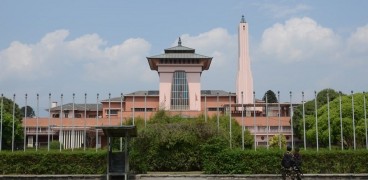Nepalese cuisine, inspired by both Indian and Tibetan cooking, has its own rich taste and aroma. Here in this blog, we have prepared a list of dishes that are not to be skipped on your trip to Nepal. Read on!
Local Nepalese Cuisine
Among the several foods served in Nepal, dal bhat and momo are the most common.
Dal Bhat
Nepal's favourite food is Dal Bhat. It is consumed regularly by Nepalis, sometimes twice a day. It is served on a steel dish and is equivalent to thali from India.

Nepali Cuisine: Flavorful Cultural Feast
Credit:Merokalam.com
You can find steamed rice in the centre of the dish and a cup of dal (dried beans and peas). A lentil broth, curried chopped veggies, and a spicy sauce (achar) mixed with chilis and seasoning are all around it. In restaurants, it can be combined with chicken or lamb bowls. Over the rice, the locals spill the warm dal, then apply the vegetables and spicy sauce.
They knead the mixture with their right hand into tiny balls before moving it with their thumb into their mouth. You can consume each food individually or combine them all with a spoon if you want to eat less like a native.
Momo (dumplings)
Another typical dish in Nepal is momo. Momos seem like tiny Chinese dumplings, said to have originated from Tibetan visitors. Made with a white flour dough, momos are then steamed and filled with chicken, vegetables, or buffalo meat.

Delicious Momo: Irresistible Himalayan Dumplings
For dipping, the dumplings are often served with a pickled sauce. You can find momos in the areas near Tibet, the mountainous country that is moon-shaped and sometimes fried.
Nepalese Cuisine are Gluten-free
Nepal is a culinary paradise for gluten-free vegans and vegetarians, with its liberal use of rice, chickpeas, lentils, and corn. Richer Nepalis and visitors are willing to vote for poultry and lamb dishes.
In this Hindu region, where cows are holy, these sources of protein are luxuries, rendering beef and veal dishes unusual.
Local Food at the Asan Market
In the winding streets and alleys of Kathmandu's Asan Market, it is possible to lose yourself. In Asan, home to this typical Asian bazaar, six streets converge. Asan divides one of two legendary trading routes that pass through Kathmandu between India and Tibet.

Nepali Spices: Aromatic Culinary Essence
Credit:centuryfood.com
In this busy marketplace, from kitchen utensils and teapots to women's garments and accessories, you can find just about everything. The region has been inhabited by small shops and stands packed with spices, vegetables, teas, pickles, molasses, nuts, and even beaten rice since ancient times.
For the eyes and the nose, it is a delight. The fruitiness of cumin and coriander, the pungent aroma of freshly roasted peanuts, and the richness of molasses can make you smell.
Spend a bit of your leisure time choosing what to buy, then be prepared to trade for better rates and still bring plenty of local currency rupees with you.
The Famous Newari Cuisine
The Newars, an ethnic indigenous group, are renowned for their unique cuisine, which is said to include 200 dishes. Be sure to try out:
- A flat crepe of rice flour, Chatamari, topped with veggies, eggs, yak cheese, and ground meat.
- Baji (bahee) is a dish that tastes like porridge oats served with veggies and spicy sauce made with beaten rice. This is Dal Bhat's edition of the Newari people.
- A salad of fried buffalo meat mixed with greens called Choyila (choyeela).
Yet Newari cuisine is best known for unique dishes made from parts of the animal body not usually found in Western cuisine. You'll see lips, spine, bone marrow, and lung dishes. Don't let the body pieces be put off. These dishes are delicious.

Yomari: Festive Sweet Delight
Credit:centuryfood.com
Yomari (yomaree), which is served at festivals to thank the deities for the good harvest, is an enjoyable snack combined with tea. The Yomari is made with a grain-flour dough, shaped like a pointing fig fruit and steamed, and filled with sugar cane molasses, ground sesame seeds, and coconut.
Nepalese Beverages
The Chhaang (chang), a rice beer, and Aylā (aeela), brewed from fermented rice and cereals, are the most traditional drinks in the Newari areas of the Kathmandu Valley. Close to tequila or sake, Raski, available in Kathmandu, is produced from distilled grain or millet.

Tongba: Warming Himalayan Tradition
Credit:tasteatlas.com
Tongba is derived from fermented millet. A pipe and a flask of hot water are served in a jug: you pour boiling water in, let it steep, and draw the beer through the straw before the bottom is reached.
Things to Know
Street food is usually healthy. Looking and wondering if the street vendor is busy and customers are purchasing from him is an easy way to determine. In most areas and towns, you can find roasted nuts, fruits, and other savoury and sweet treats.
Generally, drinking water from the tap is not healthy. Bottled water is clean, simple to find, and inexpensive. Warm water is also served at restaurants and hotels. Make sure the water has been heated before consuming hot drinks, such as tea and coffee.







